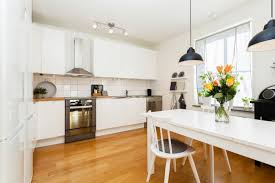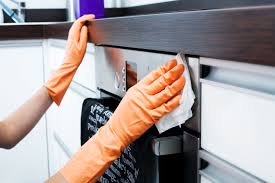Keeping your Kitchen Clean for
Longer
When it comes to maintaining your premises,
the never-ending need to constantly conduct cleaning is a challenge. But taking
a few preventative steps can help keep your kitchen clean for longer.
So, here’s our guide to some quick wins for
keeping your restaurant squared-away and tidy:
Keep your Floor Clean(er)
Taking care of nooks and crannies is
essential to help keep dirt away longer. Try to work at your grouting lines and
focus at the spaces between your tiles. Check that the staff carrying-out
cleaning know the order they should clean items and that regularly used items
like mops and sponges are thoroughly cleansed to avoid contamination. This
should also extend to any items touching the surface of the floor, including
kitchen mats, tray bottoms, or other devices you may have.
Avoid Greasy Buildups
Remember that greasy residue should always
be cleaned as soon as it occurs, as build-up will only prove costly to fix in
the long-term. Caked on grease will end up clogging your canopy fan, which can
lead to overheating, and carry the risk of slips or contamination. To help
counteract this, make sure that you conduct regular ventilation cleaning to
maximise your fan’s effectiveness. You can also try to make sure that your
tiles have an anti-slip sealing attached. Applying this sealant will help
prevent accidents and provide a helpful barrier against dirt and germs on your
floor.
Maintain your Surfaces and Windows
While it can be easy to focus on cleaning
utensils and surface-tops, windows are easy to overlook. Ensuring that windows
are clean allows your staff the best light to carry out their work and prevents
the buildup of dust and dirt that can be easily dislodged and find its way into
your preparation areas.
Maintenance as well as Cleaning
It’s important to remember that wear and
tear will inevitably happen across your kitchen. And this will make itself
known in damage to your equipment, utensils, and most-often used items. Make
sure that when you conduct regular stock, or sanitation checks that the state
of the item itself is reviewed. Keep an eye out for dents, damage and try to
catch any potential problems before they get any worse! Ideally, this should
involve regular checks on any automated cleaning equipment, processors and
fixtures.
Don’t Forget to Check your Drains
Making sure that your drains are clear is
crucially important, as build-up of grease and residue can stop a kitchen dead
in its tracks at a critical moment. And after a ‘fatberg’ was discovered under
the streets of London, making sure you dispose of residues in a responsible way
is as much as a responsibility as a benefit. Accumulations only happen over
time, so taking preventative steps is key – avoid pouring fatty or oily products
down and that you clear residue from plates and equipment before cleaning.

KITCHEN HYGIENE
clean kitchen means a healthy kitchen.
Maintaining the highest levels of hygiene will stop bugs from accumulating in
your kitchen and will also help to prevent accidents. Apart from the hygiene
and food safety aspects, kitchens can also be dangerous places to work in, with
many potential hazards like hot surfaces, slippery floors, sharp equipment and
hazardous chemicals.
Kitchen
hygiene tips
- Always clean surfaces first with detergent to remove any grease or dirt, then apply disinfectant to kill any remaining germs.
- Allow time at the end of the working day to thoroughly clean the kitchen so it’s ready for the next day.
- Surfaces and equipment that come into contact with food are the most important, but don’t forget to regularly clean walls, floors and storage areas.
- Do not just wipe surfaces and utensils with a damp cloth. Remember that towels and cloths can contain a lot of germs themselves, and you could end up simply spreading them around.
- Keep kitchens free of clutter.
- Do not allow pets into the kitchen.
- Keep the floor dry by quickly mopping up any spilled liquids.
- Cleaning substances should leave no toxic or tainting residue.
Make a
list of things to clean in a kitchen
Walk through your kitchen and make a list of everything that needs cleaning. Be
sure to review this list regularly. Also note that some equipment may need to
be cleaned more than others. Focus more on those utensils that are more likely
to be touched by food handlers, such as;
- Cooker knobs
- Can openers
- Door handles
- Fridges
- Knives
- Microwaves
- Sinks

How to Prevent Spills in the
Kitchen
Slips and trips continue to be the most
common cause of injury in European workplaces. It takes all members of staff to
create a safe working environment for everyone. We’ll cover the steps your
kitchen should already be taking and what more you can do to prevent spills and
accidents.
Keeping Your Staff Safe
It’s your responsibility to ensure that the
workplace is a safe environment. Creating a risk assessment isn’t enough when
it comes to preventing accidents. You need to be proactive.
The Right Shoes
Slips, trips and falls can all be reduced
in your kitchen by supplying staff with the right footwear. Depending on their
job role, you can provide chefs, kitchen staff and waiters/waitresses with
specialist non slip footwear to keep them safe and comfortable while they work.
When looking for footwear for staff, look for shoes that have been designed
with slip-resistant outsoles, preventing the wearer from falling even if the
floor is wet. Some designs have TripGuard that can stop falls when moving
between different floor surfaces.
The Right Training
Your staff should receive regular safety
training so that they’re fully aware of the hazards in the kitchen and what
they can do to minimise risk. They might find this boring and unnecessary, but
it shows them that you care about their health and wellbeing. The team should
take pride in the kitchen and even though it isn’t seen by customers, it should
be just as important as front of house. Don’t leave cleaning to the same people
and encourage the whole team to help. Training is just one step towards a
culture of care and safety in your kitchen. Staff should want to keep the
kitchen safe, clean and tidy, rather than have to be told to do it. They’ll
need the right equipment and clothing to be able to improve health and safety.
The Right Tools
To keep the kitchen safe, your staff need
the right tools and equipment. Knowing the equipment best suited to a
particular cleaning task is important and staff should have the right tools on
hand. From disinfectants to the right kind of scrubbing pads, make sure staff
have all the equipment they need to leave the kitchen looking spotless. It’s
also important to think about the floor in areas of the kitchen, including
fridges and outdoor areas. Spots that are more likely to be wet could benefit
from safety mats to prevent the floor from becoming too slippery. Different
floor surfaces are more at risk of becoming dangerous. Determine the kinds of
floor surfaces you have in your kitchen and take the necessary steps as
outlined in the Health and Safety Executive’s helpful table.

Explains Accident Prevention
“Prevention is better than a
cure” is an old and popular proverb, which means it is better to stop bad
things from happening, than to fix them after they have already happened.
Accidents are preventable, but steps must be taken to prevent them. It is a legal
obligation of organizations to comply with the laws, standard practices, and
safety observations to avoid emergencies and accidents.
Many accidents occur due to human factors.
These factors include unsafe acts, un-mindfulness, negligence, lack of
knowledge and training. Another leading factor of accidents is working
conditions. Unsafe working conditions can include faulty machines, faulty
designs, substandard processes, occupational hazards, fire and other hazards,
etc.. Accidents will continue to happen if preventative measures are not taken.
Accident prevention can be achieved by commitment and cooperation between
management, safety programs, safety culture and accountability. Prevention
requires the following actions:
- Hazard identification by risk
assessment
- Removal of unsafe work by
research and development
- Removal of unsafe machines,
tools and improvement of working conditions and environments
Slips, trips, and falls
Kitchens often have numerous slip, trip,
and fall risks created by human error, meaning you and others need to focus
closely on proper safety practices and housekeeping.
Slip,
trip, and fall hazards include:
- Floor contamination, such as spillages of water, sauces, oil, and flour.
- Wet floors from cleaning.
- Obstructions in walkways, including trailing cables, boxes and crates, bins, cleaning equipment, etc.
- Uneven, worn down, or loose flooring.
- Using a ladder to access high pantry shelves.
- Standing in a truck to unload deliveries.
Preventing floor contamination is critical
as people are constantly moving around on their feet, sometimes while
transporting hot food that could spill onto them if they fell.
To
minimise slip, trip, and fall hazards, you should:
- Carry out good housekeeping – clean spillages and move obstructions out of walkways right away.
- Take extra care while cleaning – avoid leaving puddles behind and make sure the cleaning materials you’re using are correct for the type of floor in your kitchen. Dry mop where possible to eliminate slip risks altogether.
- Keep cables out of walkways – use the nearest plug socket for appliances.
- Report any issues with the flooring or work activities that are generating hazards when they shouldn’t, for example leaking equipment.
- Use ladders in accordance with safety instructions – rest ladders on a firm, level surface and only use them for up to 30 minutes. Do not lift more than 10kg up a ladder.
- Avoid accessing heights without a suitable ladder – chairs and shelves are unsafe to stand on.
- Carry out deliveries with a co–worker – working with someone minimises the amount of times you have to step on and off the back of a truck and put yourself at risk of falling.